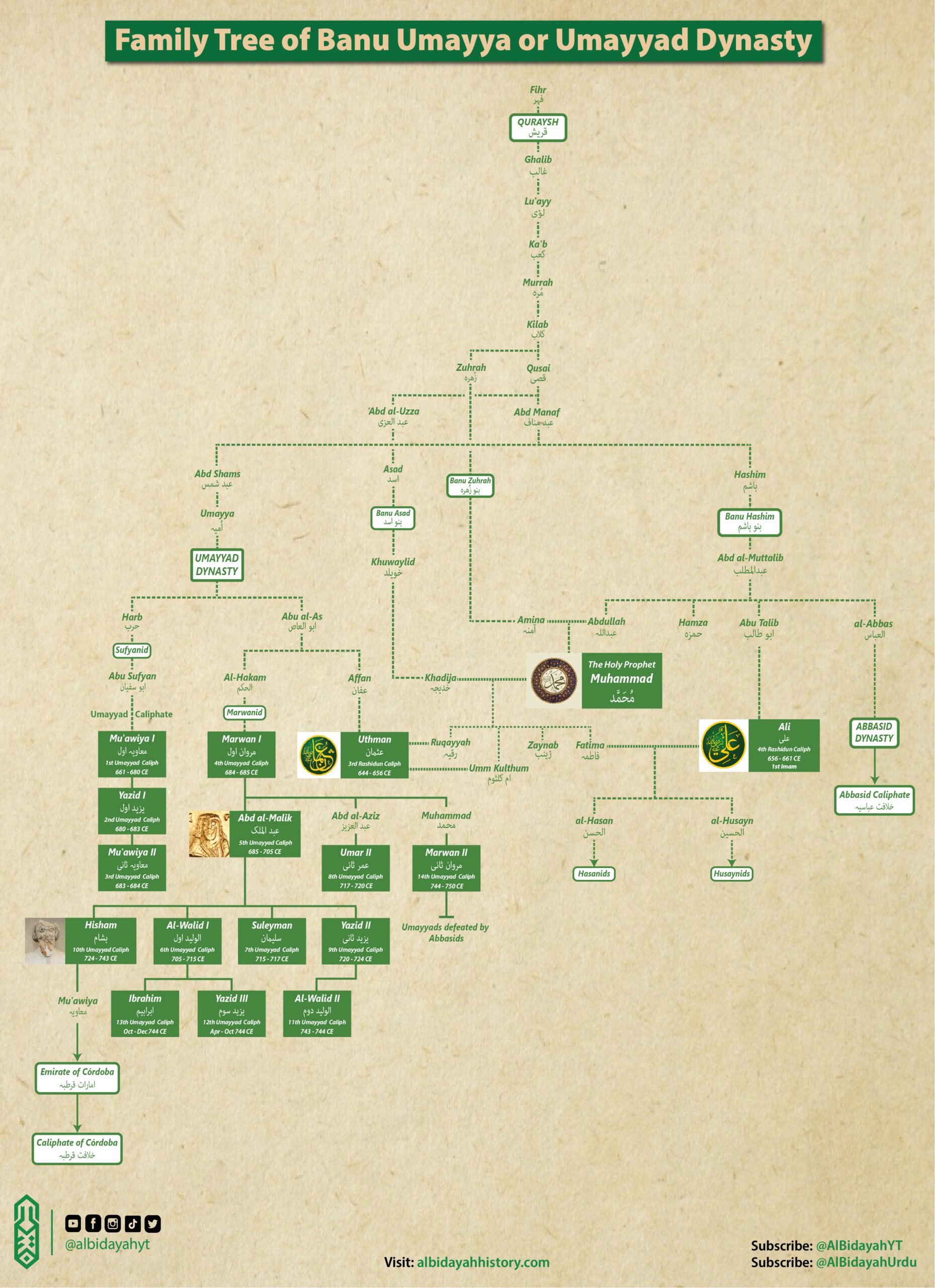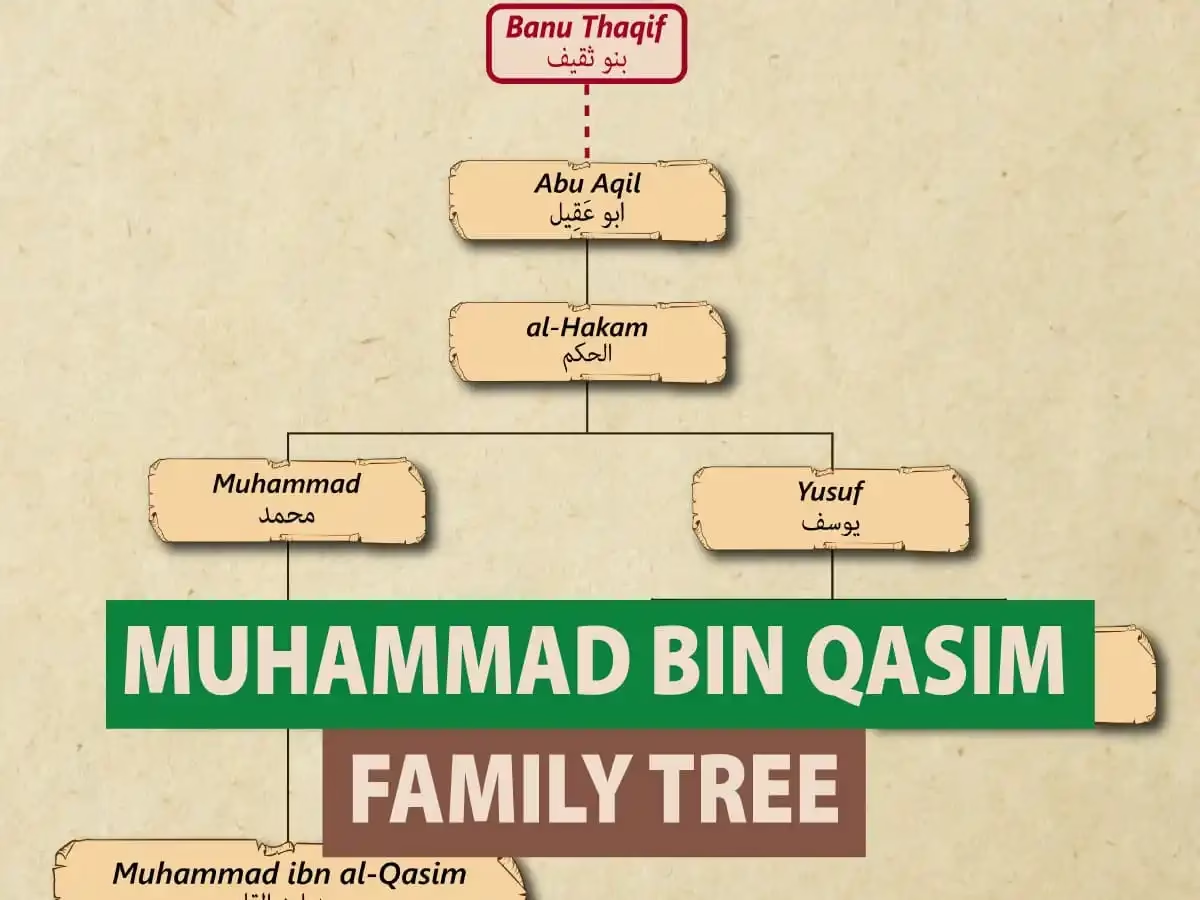This chart illustrate Family Tree of Banu Umayya (Umayyad Dynasty), from Quraysh to Marwan II in English & Urdu. Banu Umayya, commonly referred to as the Umayyads, form one of the most significant dynasties in Islamic history. This family is directly linked to the early leadership of the Muslim Ummah after the Rightly Guided Caliphs, and their contributions have been profound in shaping the Islamic world.

Genealogical Background
The family of Banu Umayya traces its ancestry back to Fihr, an ancestor of the Quraysh tribe in Mecca. The Umayyads are a branch of the larger Quraysh tribe, which played a crucial role in pre-Islamic and early Islamic society. Their genealogical tree intersects with the Banu Hashim family, to which Prophet Muhammad (PBUH) belonged. Both families descend from Abd Manaf, making the Umayyads and the Hashimites distant relatives.
Key Figures and Early Leadership
- Abd Manaf and Abd Shams
Abd Manaf, a common ancestor, had several sons. One of his sons, Abd Shams, fathered Umayya, after whom the Umayyad dynasty is named. Abd Shams’ descendants include key figures in the Umayyad Caliphate, particularly the Sufyani and Marwani branches. - Umayya and his Descendants
The Umayyad family began to rise in prominence through Umayya’s descendants, including Harb, Abu al-As, and Abu Sufyan. Abu Sufyan, an influential figure in the early Islamic period, initially opposed Prophet Muhammad (PBUH) but later embraced Islam after the conquest of Mecca. His son, Mu’awiya I, would later become the first Umayyad Caliph, marking the beginning of the dynasty’s rule.
See Also: Banu Hashim Family Tree
Branches of the Umayyads
The family tree shows two main branches of the Umayyad family:
- The Sufyani Branch: Descendants of Abu Sufyan, including the early Umayyad Caliphs like Mu’awiya I and Yazid I, and a son of Yazid I, Mu’awiya II.
- The Marwani Branch: Descendants of Marwan I, who took over after the decline of the Sufyani line. The Marwanids ruled from Abd al-Malik onward and played a significant role in strengthening the empire.
Umayyad Caliphate/Empire
The Umayyad Caliphate or Empire began after the tumultuous end of the Rightly Guided Caliphs. Mu’awiya I, son of Abu Sufyan, established the Umayyad dynasty in 661 CE. He shifted the capital from Medina to Damascus, bringing significant administrative changes and expansion to the empire.
Key figures in the Umayyad dynasty include:
- Mu’awiya I (661-680 CE): The founder of the Umayyad Caliphate.
- Yazid I (680-683 CE): His rule witnessed the tragic events of Karbala and the martyrdom of Imam Hussain, a grandson of Prophet Muhammad (PBUH), marking a deep division in the Muslim world.
- Marwan I (684-685 CE) and Abd al-Malik (685-705 CE): Both were pivotal in consolidating Umayyad rule and expanding the empire.
- Umar II (717-720 CE): Known for his piety and reforms, he is regarded as one of the most just rulers of the dynasty.
Umayyad Legacy
The Umayyads were instrumental in spreading Islam across a vast region, from the Iberian Peninsula (modern-day Spain and Portugal) to the Indus Valley. Their expansion stretched across three continents—Asia, Africa, and Europe. The Umayyad dynasty’s governance style involved strong centralized control, reliance on local administrators, and the introduction of Arabic as the administrative language across the empire.
The dynasty reached its peak during the reign of Abd al-Malik and his son Al-Walid I, who expanded the empire further and made Damascus a major center of Islamic culture. However, internal conflict, including revolts by non-Arab Muslims (Mawali), led to the decline of the dynasty.
Umayyads vs. Abbasids
The family tree also highlights the rivalry between the Umayyads and the Abbasids, who claimed descent from the Prophet’s uncle Abbas and eventually overthrew the Umayyads in 750 CE. The Abbasids moved the capital to Baghdad and ruled a new era of Islamic civilization, but the Umayyads continued their rule in Al-Andalus, creating two parallel caliphates.
See Also: Muhammad bin Qasim Family Tree
Conclusion
The Umayyad dynasty holds a significant place in Islamic history. Despite their eventual defeat by the Abbasids, their contributions to the expansion of Islam, administrative reforms, and cultural achievements have left a lasting legacy. The survival of their lineage in Spain through the Caliphate of Cordoba ensured that their impact on Islamic civilization would continue long after the fall of their central empire.
Family Tree of Banu Umayya (Umayyad Dynasty) | Umayyad Caliphate Family Tree




Great article! The family tree really helps in understanding the connections between key figures in Islamic history. It’s fascinating how the Umayyad legacy continued in Spain even after their downfall in the east. I always wondered how they managed to expand their rule so far and wide. This definitely gives a clearer picture of their role in shaping the early Islamic empire!
Excellent job